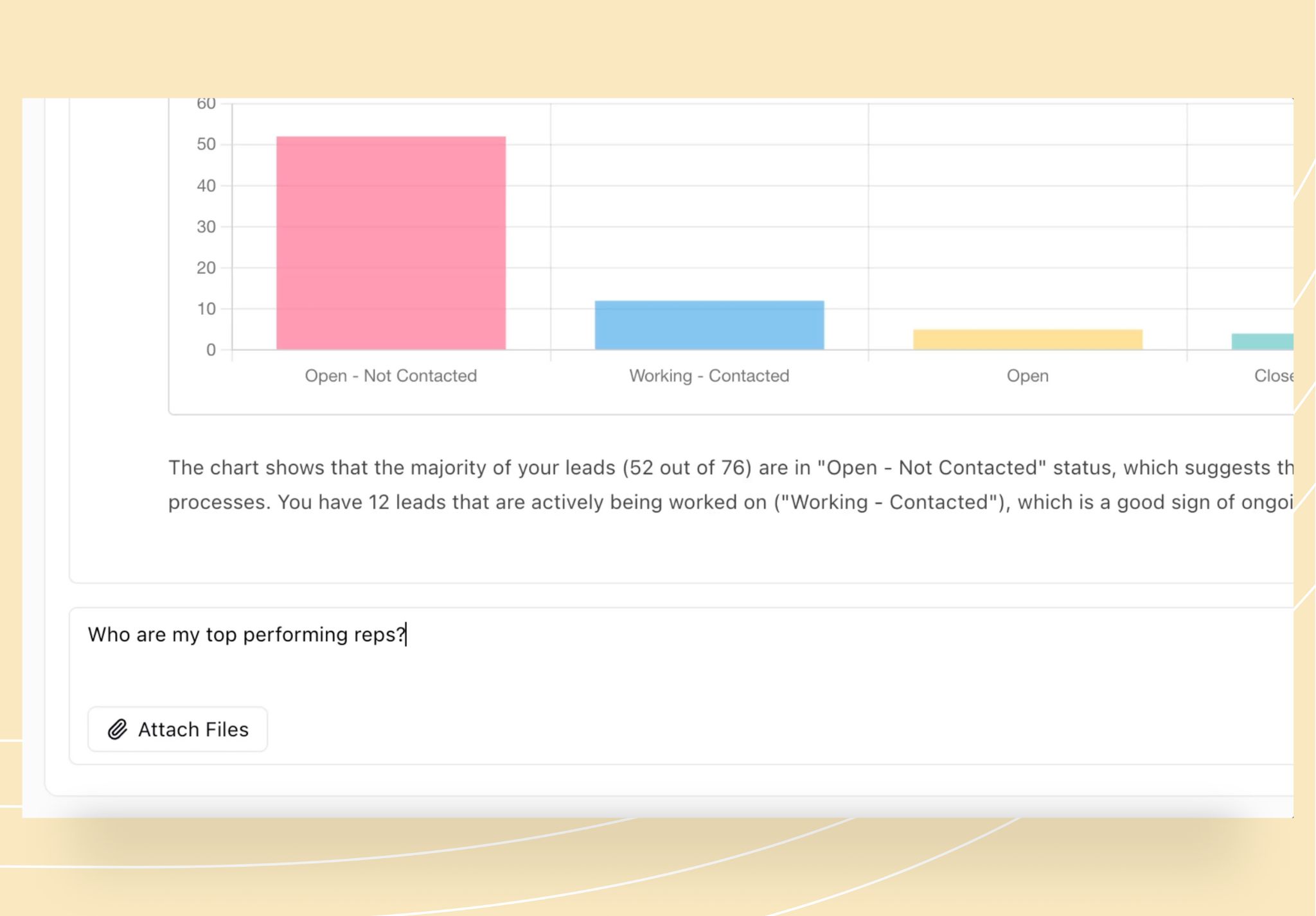The Hidden Drag of Manual Sales Operations
Why B2B teams still waste hours on repetitive tasks
Many B2B sales teams still rely on manual data entry, follow-ups, and reporting tasks that consume valuable selling time. Without automation, reps spend more time on administration than on closing deals, limiting overall productivity.
The cost of missed opportunities without business process automation
Without business process automation, leads often slip through the cracks. Missed follow-ups, delayed responses, and inconsistent workflows mean lost revenue opportunities and weaker customer engagement.
How administrative overload slows deal velocity
When sales reps are buried under spreadsheets, scheduling, and reporting, deals stall. Administrative overload creates friction in the pipeline, making it harder to respond quickly to buyer intent and slowing down overall deal velocity.
Automate Business Processes with Zams.
Zams seamlessly integrates with your existing sales stack and tools, ensuring smooth data flow and minimal disruption.
Try Zams today and see automation in action.

The Core Value of Business Automation Software
Defining business process automation and why it matters for sales
Business process automation is the use of technology to streamline repetitive, manual tasks across the sales cycle. By automating workflows like lead routing, reporting, and pipeline tracking, sales teams gain more bandwidth to focus on revenue-driving activities. These tools enable organizations to automate processes and digitize operational workflows, reducing manual effort and increasing efficiency.
Key differences between automated business software and generic tools
Unlike generic task tools, automated business software is purpose-built for process efficiency. It integrates seamlessly with CRMs and other sales platforms, ensuring workflows are unified, scalable, and tailored for measurable business growth. Additionally, automated business software often provides a comprehensive suite of features designed for end-to-end process management.
Where process automation tools deliver measurable impact
The key benefits of process automation tools include improved efficiency, greater accuracy, and enhanced scalability for business operations.
From faster response times to improved reporting accuracy, process automation tools deliver clear ROI. They reduce operational bottlenecks, accelerate decision-making, and empower sales teams to scale with precision.
Essential Functions of Business Process Automation Tools
Streamlining lead capture and qualification workflows
Business process automation tools ensure every inbound lead is captured instantly and routed to the right rep. Workflow templates allow teams to quickly set up and customize automated lead capture and qualification processes, making it easy to adapt workflows to specific business needs. By automating qualification criteria, teams filter out low-value prospects and focus only on high-intent opportunities, driving higher win rates.
Automating sales reporting and forecasting with BPA tools
Manual reporting slows teams down and risks errors. With BPA tools, sales data flows directly into dashboards, enabling real-time forecasting that helps leaders spot trends, allocate resources, and make faster, data-driven decisions. These tools also provide valuable insights into sales performance and trends, empowering teams to analyze results and optimize their strategies.
Removing friction from approvals, pricing, and contract processes
Approvals and contract management are often the biggest roadblocks in enterprise sales. Automating invoice processing streamlines accounts payable workflows and reduces manual intervention. Business process automation software eliminates delays by automating pricing approvals, generating compliant contracts, and reducing turnaround time from weeks to days. Effective document management supports digital contract workflows and enhances compliance.

Building Predictable Growth with Business Process Automation Software
How business process automation tools improve pipeline accuracy
By consolidating data across CRM, marketing, and finance, business process automation software delivers a single source of truth for pipeline health. This accuracy improves forecasting reliability and builds confidence in revenue projections.
Real-time insights for leadership and revenue planning
With real-time insights, sales leaders can track KPIs, monitor rep activity, and spot bottlenecks before they impact revenue. This visibility enables smarter revenue planning and faster adaptation to shifting market conditions.
The link between automation and shorter sales cycles
Every manual handoff adds time to the sales process. By automating workflows like follow-ups, document generation, and approvals, BPA tools remove friction, resulting in shorter sales cycles and accelerated revenue capture.
Scaling Personalisation Without Manual Effort
Leveraging business process automation software for tailored outreach
Business process automation software enables sales teams to deliver personalised outreach at scale. By tapping into CRM and customer data, reps can send messages that reflect buyer context without adding manual workload.
Trigger-based actions that respond to buyer intent instantly
With BPA tools, actions like follow-up emails, demo invites, or pricing updates can be triggered the moment a buyer shows intent. This real-time responsiveness ensures sales teams engage prospects when interest is highest.
Aligning automated touchpoints with human sales interactions
Automation doesn’t replace authentic sales engagement it amplifies it. By aligning automated business software with key human touchpoints, teams create a seamless buyer experience that balances efficiency with trust. Maintaining human interaction alongside automated processes ensures that personal connections and genuine engagement remain central to the sales journey.
Measuring the Success of Business Automation
Effectively measuring the success of business automation is essential for maximizing the impact of your business processes and ensuring continuous improvement. With the right business process automation tools, organizations can track the performance of automated processes, identify areas for optimization, and streamline workflows to achieve greater efficiency and growth. By focusing on data-driven insights, businesses can ensure their process automation strategies deliver measurable results and support long-term objectives.
Key metrics to track automation ROI in B2B Sales
To truly understand the return on investment from process automation, it’s important to monitor a set of key metrics that reflect both operational and strategic gains:
- Reduction in manual tasks and repetitive tasks: Track how many routine activities have been automated, freeing up valuable time for your team.
- Increase in employee productivity and customer satisfaction: Measure improvements in output and the quality of customer interactions as a result of workflow automation.
- Improvement in process automation and workflow automation: Assess how automated workflows have enhanced the speed and consistency of business operations.
- Cost savings through optimized resource utilization: Calculate reductions in operational costs by automating resource-intensive processes.
- Enhancement in operational excellence and strategic initiatives: Evaluate how automation supports broader business goals and drives continuous improvement.
- Reduction in human errors and improvement in accuracy: Monitor error rates before and after automation to ensure higher data quality and compliance.
By regularly tracking these metrics, businesses can demonstrate the tangible benefits of process automation and make informed decisions about future investments.

How to assess performance improvements and pipeline health
Assessing the impact of automation on business processes and pipeline health requires a structured approach:
- Monitor key performance indicators (KPIs): Focus on metrics such as cycle time, throughput, and quality to gauge the effectiveness of automated workflows.
- Analyze automated workflows for bottlenecks: Use automation software to visualize workflow processes and quickly identify areas where delays or inefficiencies occur.
- Evaluate the impact on business operations: Regularly review how automation is influencing overall business processes, ensuring alignment with business requirements and strategic goals.
- Conduct regular reviews of automation tools: Ensure your process automation software continues to meet evolving needs and supports intelligent automation capabilities.
- Leverage artificial intelligence: Integrate AI-driven insights to further optimize processes, predict outcomes, and enhance decision-making.
This ongoing assessment helps organizations maintain healthy pipelines, adapt to changing business requirements, and optimize processes for maximum impact.
Continuous optimization based on data-driven insights
Continuous improvement is at the heart of successful business process automation. To keep automated processes delivering value:
- Regularly review and analyze data: Use analytics from your automation software to monitor the performance of automated workflows and identify opportunities for refinement.
- Implement changes based on insights: Act on data-driven findings to streamline processes, eliminate bottlenecks, and boost productivity.
- Leverage advanced automation tools: Adopt solutions like Microsoft Power Automate, which offers a drag-and-drop interface and seamless integration with a wide range of business applications, making it easy to automate repetitive tasks and optimize workflows.
- Encourage a culture of innovation: Foster an environment where continuous improvement and the adoption of new technologies such as robotic process automation and digital process automation are embraced.
- Stay current with industry trends: Keep up with advancements in process automation to ensure your business remains competitive and efficient.
By prioritizing continuous optimization, businesses can ensure their automation initiatives remain effective, drive operational excellence, and consistently deliver higher levels of customer satisfaction. This proactive approach not only streamlines workflows but also positions organizations for sustained growth and success in an increasingly digital landscape.
Avoiding Pitfalls When Adopting Automated Business Software
Over-automation that risks authenticity in sales interactions
Too much automation can make interactions feel robotic. Successful adoption of automated business software requires striking a balance between automated workflows and genuine, personalised human engagement.
Poor integration planning with existing systems and BPA tools
Implementing business process automation tools without proper integration leads to silos and inefficiencies. Careful planning ensures systems like CRM, email, and analytics connect seamlessly, so data flows across the sales stack.
Ensuring team adoption and process alignment
The value of business process automation software is only realised when teams actually use it. Training, clear processes, and aligning automation with daily workflows drive adoption and ensure BPA delivers measurable impact.
Final Thoughts
Business automation software has shifted from a back-office efficiency tool to a frontline driver of B2B sales growth. By automating lead capture, reporting, and repetitive processes, sales teams gain back hours each week and close deals with greater precision. When aligned with strategic goals, automation not only accelerates pipeline velocity but also delivers a more personalised buyer experience that drives predictable revenue growth.
Equip Your Sales Growth with Zams + Business Automation Software
Zams connects your sales stack with the power of business process automation software. Zams unifies your sales stack into one automated system - streamlining every stage from lead to close. From lead qualification to pipeline forecasting, Zams eliminates inefficiencies, ensures seamless integrations, and keeps your reps focused on what matters most winning deals.
FAQ
What is business automation software in B2B sales?
Business automation software streamlines repetitive processes like lead capture, reporting, and approvals, helping B2B sales teams save time and close deals faster.
How does business process automation improve sales performance?
By eliminating manual tasks, business process automation tools free sales reps to focus on customer engagement, improve pipeline accuracy, and accelerate revenue growth.
What are the essential functions of business process automation tools?
Core functions include automating lead management, sales reporting, contract approvals, and forecasting, all of which reduce friction and increase sales efficiency.
Can business automation software personalise customer interactions?
Yes. Automated business software uses trigger-based workflows and data-driven insights to deliver tailored outreach and align touchpoints with buyer intent.
What pitfalls should B2B teams avoid when adopting automation?
Teams should avoid over-automation, poor integration planning, and lack of adoption. Ensuring alignment with strategy and systems maximises ROI from automation.



